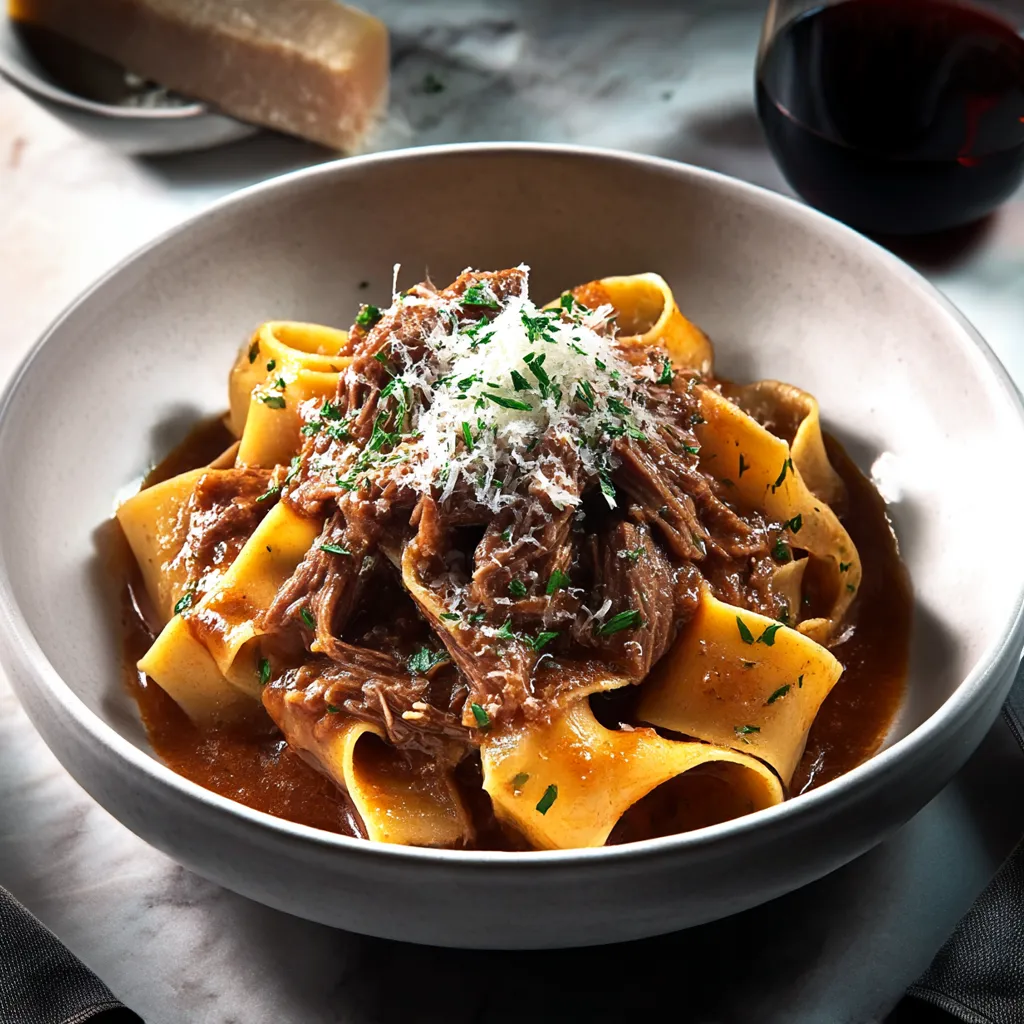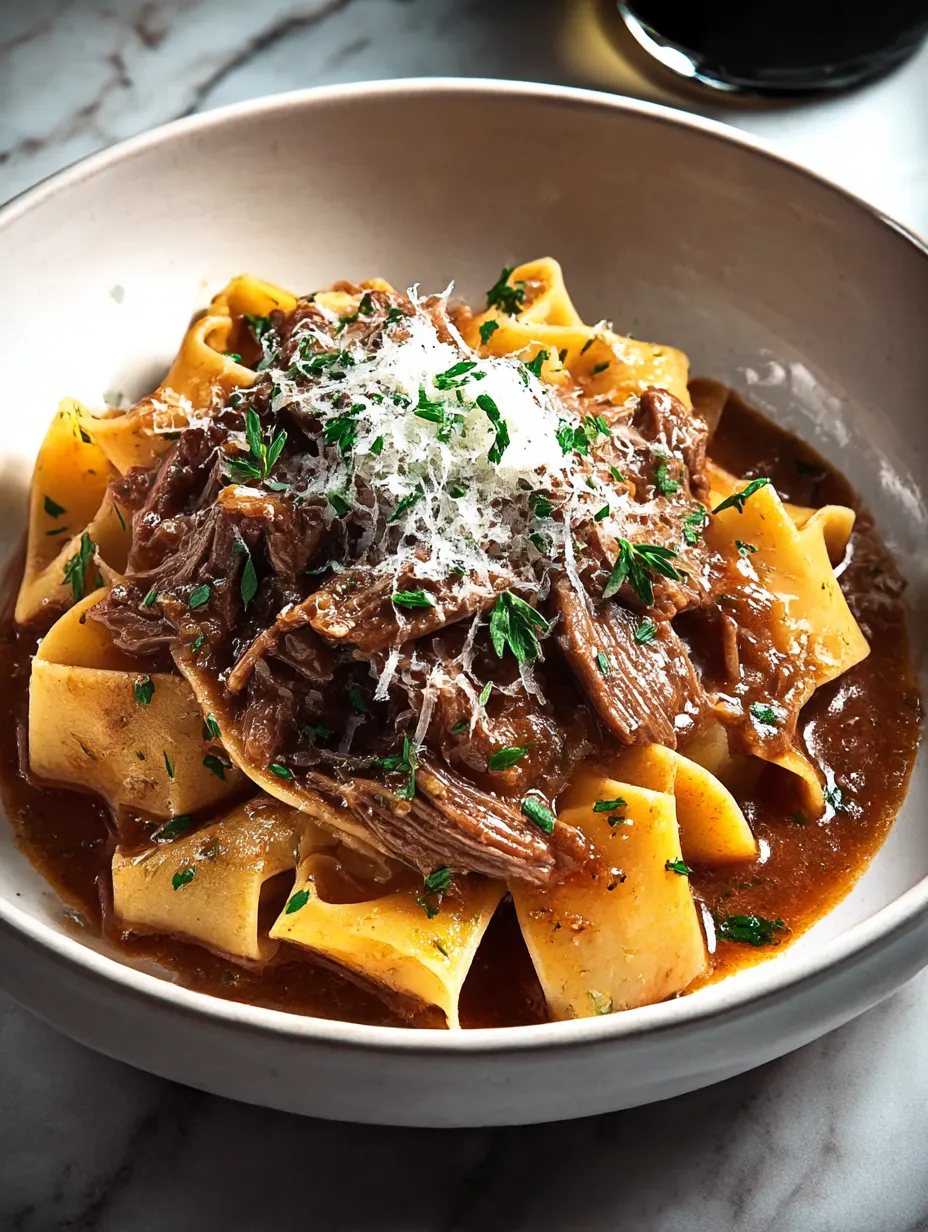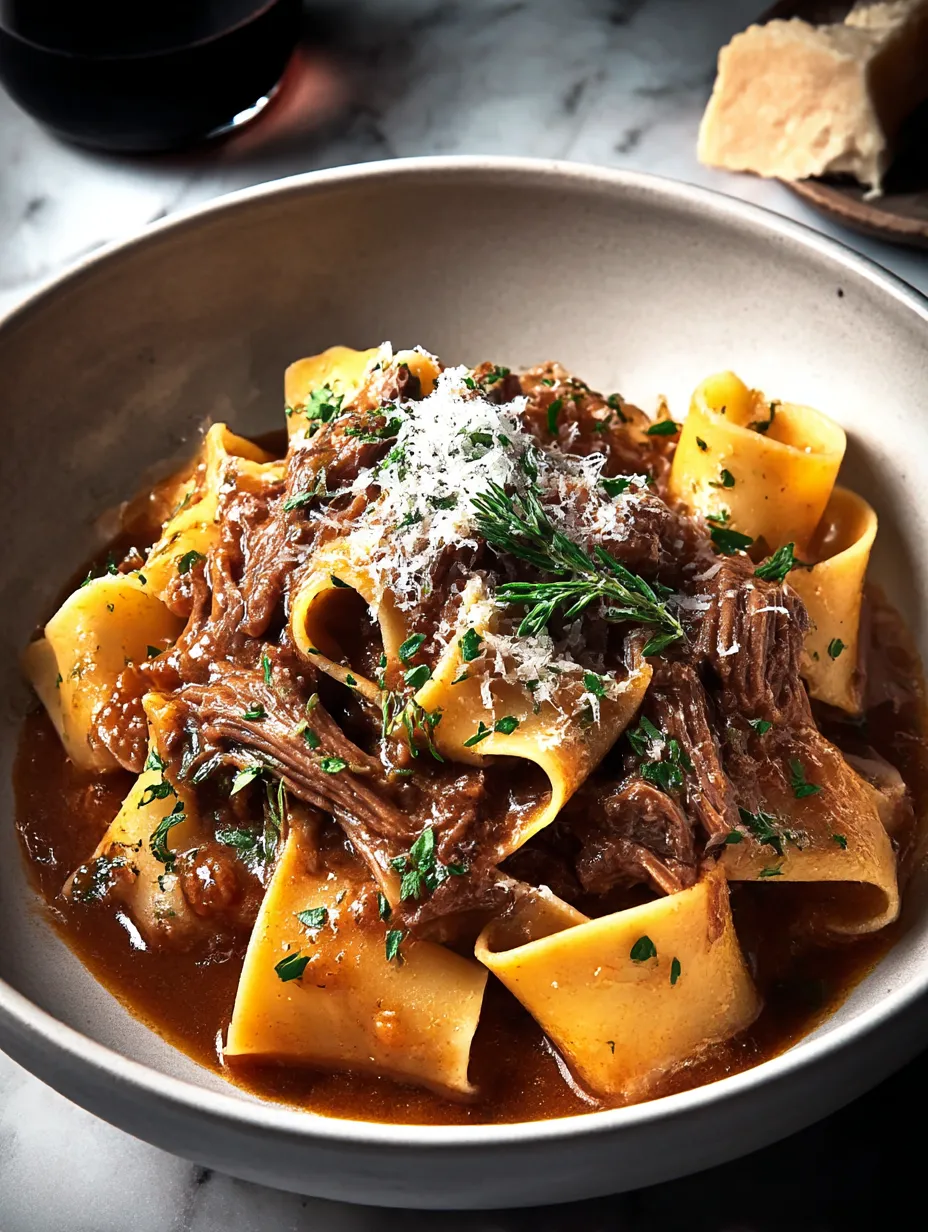 Pin it
Pin it
This rich beef ragu with pappardelle turns simple ingredients into an amazing meal through patient cooking. The fall-apart beef chunks in deep tomato sauce paired with wide pappardelle pasta brings fancy restaurant vibes straight to your dinner table.
I whipped up this ragu during a freezing winter weekend when I wanted something cozy yet impressive for some friends coming over. My whole house smelled amazing for hours and those friends still mention it as the tastiest pasta they've ever tried.
What You'll Need
- 2 pounds beef chuck roast: This cut becomes super tender after slow cooking. Try to find pieces with good fat marbling for better taste
- 3 tablespoons olive oil: Grab a decent extra virgin olive oil for browning to build rich taste
- Celery, onion, and carrots: This veggie trio forms your flavor base. Chop them small for the best texture in your sauce
- 4 cloves garlic: Brings wonderful aroma. Stick with fresh instead of jarred for better flavor
- 28 oz can crushed tomatoes: Creates your sauce foundation. Splurge on San Marzano if you can
- 2 cups beef broth: Adds meaty depth and right thickness. Go for low-sodium if you can find it
- 2 tablespoons tomato paste: Makes tomato flavor stronger and thickens everything up. Cook it briefly to kill that raw taste
- Dried thyme and oregano: Gives your sauce Italian character. Rub between your fingers before adding to wake up the oils
- 2 bay leaves: Adds subtle background flavor. Don't forget to take them out before eating
- 1 pound pappardelle pasta: These wide noodles catch all that chunky sauce perfectly. Fresh is fantastic but dried works fine too
Cooking Guide
- Brown Your Beef:
- Sprinkle beef chunks with plenty of salt and pepper. Pour olive oil in a Dutch oven and heat until it shimmers, then add beef in small batches so they don't crowd each other. Let each piece get really brown before flipping, about 3 minutes per side. This step builds massive flavor for your whole dish. Put browned meat on a plate and continue with the rest.
- Create Your Flavor Base:
- Toss remaining oil in the same pot with your celery, carrot, and onion mix. Cook on medium for 7 minutes, stirring now and then until veggies soften and start to brown slightly. All those tasty bits from the beef will mix into your veggies, creating amazing depth.
- Start Your Sauce:
- Toss in garlic and cook just until you can smell it, about 1 minute, stirring the whole time so it doesn't burn. Add tomato paste and cook for 3 minutes, stirring non-stop. This gets rid of that tinny flavor. Pour in your tomatoes and broth while scraping the pot bottom to get all the brown bits. Add herbs and put beef back in with any juices on the plate.
- Let It Simmer:
- Bring to a gentle bubble then turn heat down to keep it barely simmering. Half-cover the pot so some steam can escape to thicken things up. Let it cook for 2 to 2.5 hours, checking now and then to make sure it's not boiling too hard. Your beef is ready when it falls apart easily with a fork.
- Shred The Meat:
- Take beef chunks out onto a cutting board. Use two forks to pull the meat into small strands, getting rid of any fatty or tough bits. Put the shredded beef back in the sauce and cook 10 more minutes so the meat soaks up all that flavor. Taste and add more salt if needed.
- Boil Your Pasta:
- Fill a big pot with water, bring to a rolling boil and add lots of salt until it tastes like seawater. Drop in your pappardelle and cook until just firm to the bite, 1 minute less than the package says. Save a cup of the starchy water before draining.
- Combine Everything:
- Put drained pasta right into your ragu with a splash of the pasta water. Gently toss it all together for 1-2 minutes, letting the pasta soak up some sauce. The starchy water helps sauce stick to every pasta strand and makes everything silky smooth.
 Pin it
Pin it
Chuck roast really makes this dish special. I first learned about its magic when I started making slow-cooked meals years ago. It starts off tough but after hours of gentle heat, it changes completely. My family now knows exactly what's cooking the second they walk in the door just from the smell of this ragu.
Keeping Leftovers
This ragu actually gets tastier over time as all the flavors blend together. Keep sauce separate from pasta in sealed containers in your fridge for up to 4 days. When warming it up, add a little beef broth or water since it thickens a lot when cold. Heat it slowly on medium-low, stirring every so often so it doesn't burn.
Mix It Up
Feel free to make this recipe your own based on what's in your kitchen. Try swapping half a cup of the beef broth with dry red wine for extra depth. Want it richer? Add 2 tablespoons of butter when you put the shredded beef back in the sauce. If you're out of chuck roast, you can use beef short ribs or even ground beef instead, though it'll feel different in your mouth.
What To Serve With It
Pair this hearty ragu with a simple arugula salad with just lemon juice and olive oil – the brightness cuts through the rich dish nicely. Don't forget some crusty Italian bread to soak up every bit of sauce. For wine, go with a medium-bodied red like Chianti or Montepulciano d'Abruzzo that can stand up to the bold flavors without taking over.
Where It Comes From
Ragu started in Northern Italy where folks would slow cook meat with veggies and tomatoes to make something special from basic ingredients. Traditionally left simmering all day on a back burner, this dish shows off the Italian way of turning simple stuff into amazing food through time and technique. Real Italian versions might use less tomato than we do here, but the idea of tender meat in flavorful sauce stays true to its roots.
 Pin it
Pin it
Frequently Asked Questions
- → Is this meal good for prepping in advance?
Totally! It’s even more flavorful after resting overnight. Keep it in a closed container in the fridge for three days max. Warm it up gently when ready to eat.
- → What other beef cuts work for this?
Definitely! If chuck roast isn’t available, try brisket or short ribs. Both become amazingly tender after slow-cooking.
- → Can I freeze leftovers?
Yes, this freezes nicely! Transfer the sauce into a freezer-safe container, and it’ll keep fresh for three months. Thaw it in the fridge before reheating it.
- → Can another pasta replace pappardelle?
For sure. You can use tagliatelle, fettuccine, or any wide pasta that holds on to sauces well.
- → How do I make a dairy-free version?
It’s easy! Just leave out the Parmesan. Use fresh herbs as a topping instead for a tasty, dairy-free option.
